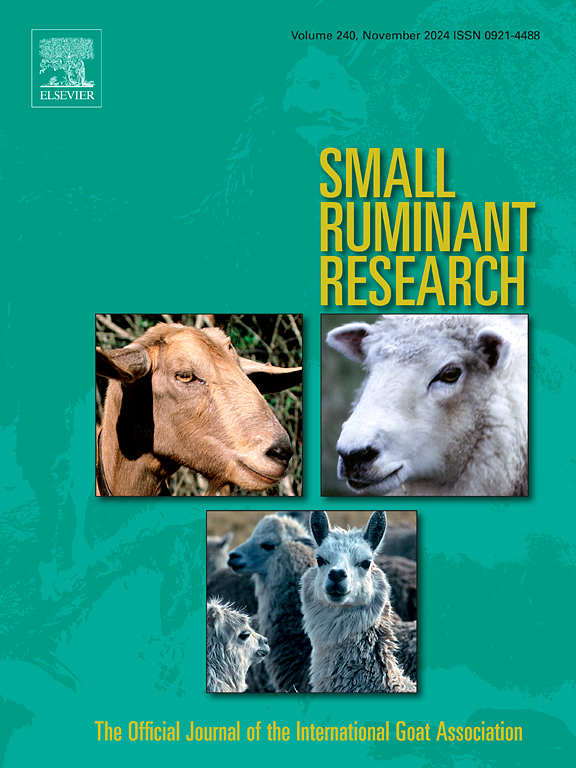比较三明治酶联免疫吸附法和 PCR 检测绵羊和山羊小反刍兽疫的效果
IF 1.4
3区 农林科学
Q2 AGRICULTURE, DAIRY & ANIMAL SCIENCE
引用次数: 0
摘要
本研究的主要目的是调查夹心酶联免疫吸附法与 RT-PCR 技术相比在检测临床患病绵羊和山羊的小反刍兽疫(PPR)感染方面的诊断性能。次要目的是比较基于 N 基因和 F 基因的 RT-PCR 在确定 PPR 感染方面的结果。在伊拉克尼尼微省的不同羊群中采集了 400 只出现 PPR 临床症状的动物(335 只绵羊和 65 只山羊)的血样和鼻拭子。使用 s-ELISA 对血清样本进行检测,而使用 RT-PCR 对鼻拭子进行检测。分析表明,s-ELISA、N 基因 RT-PPR 和 F 基因 RT-PCR 的阳性率分别为 43%、40% 和 34%。s-ELISA 的诊断准确性、敏感性、特异性、阳性预测值、阴性预测值和诊断几率比分别为 0.93、94%、92%、88%、96% 和 185。共有 25 份(16%)N 基因 RT-PCR 阳性样本经 F 基因 RT-PCR 检测为阴性。总之,尽管我们使用鼻拭子进行了 RT-PCR,而使用血清样本进行了 s-ELISA,但 s-ELISA 可以作为 RT-PCR 的一种实用检测方法,替代 RT-PCR,检测观察到疾病临床症状的绵羊和山羊血清样本中的 PPR 感染。本文章由计算机程序翻译,如有差异,请以英文原文为准。
Comparison of the efficacy of Sandwich ELISA with PCR for detecting Peste des Petits Ruminants in sheep and goats
The primary objective of this study was to investigate the diagnostic performance of sandwich ELISA compared to the RT-PCR technique in detecting Peste des Petits Ruminants (PPR) infection in clinically diseased sheep and goats. A secondary objective was to compare the results of N-gene- and F-gene-based RT-PCR in identifying PPR infection. Blood samples and nasal swabs were collected from 400 animals (335 sheep and 65 goats) exhibiting clinical signs of PPR in different flocks in Nineveh governorate, Iraq. Serum samples were tested using s-ELISA, whereas nasal swabs were tested using RT-PCR. The analysis indicated that s-ELISA, N-gene RT-PPR, and F-gene RT-PCR had 43 %, 40 %, and 34 %, respectively, positive results. The diagnostic accuracy, sensitivity, specificity, positive predictive value, negative predictive value, and diagnostic odds ratio of s-ELISA were 0.93, 94 %, 92 %, 88 %, 96 %, and 185, respectively. A total of 25 (16 %) samples positive with N-gene RT-PCR tested negative with F-gene RT-PCR. In conclusion, although we performed RT-PCR using nasal swabs and s-ELISA using serum samples, s-ELISA can be a practical test alternative to RT-PCR for detecting PPR infection in serum samples from sheep and goats observing clinical signs of the disease.
求助全文
通过发布文献求助,成功后即可免费获取论文全文。
去求助
来源期刊

Small Ruminant Research
农林科学-奶制品与动物科学
CiteScore
3.10
自引率
11.10%
发文量
210
审稿时长
12.5 weeks
期刊介绍:
Small Ruminant Research publishes original, basic and applied research articles, technical notes, and review articles on research relating to goats, sheep, deer, the New World camelids llama, alpaca, vicuna and guanaco, and the Old World camels.
Topics covered include nutrition, physiology, anatomy, genetics, microbiology, ethology, product technology, socio-economics, management, sustainability and environment, veterinary medicine and husbandry engineering.
 求助内容:
求助内容: 应助结果提醒方式:
应助结果提醒方式:


